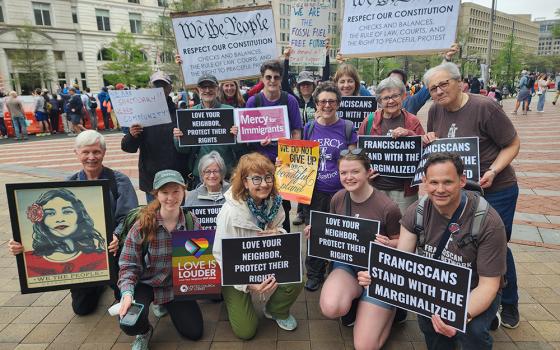Author's note: My friend Shane Claiborne, one of the most popular progressive evangelicals in the world, asked me to write about civil disobedience for his website, redletterchristians.org, which I recommend as a great source of inspiration. I share this essay as we enter Holy Week to encourage everyone on journeys with the nonviolent Jesus.
Twenty years ago, on Dec. 7, 1993, Philip Berrigan, Lynn Fredriksson, Bruce Friedrich and I walked on to the Seymour Johnson Air Force Base near Goldsboro, N.C., through thousands of soldiers to one of the 75 F-15E nuclear-capable fighter bombers on alert to bomb Bosnia, and each hammered on it. We were trying to fulfill Isaiah's commandment to "beat swords into plowshares." We were arrested, charged with two felony convictions each and faced 20 years in prison. I did about nine months in jail and a year and a half under house arrest. To this day, I'm still carefully monitored by the government, can't vote, can't visit prisoners and can't travel to several countries. This, along with my arrest record, is normal for those of us who are spending our lives in nonviolent resistance to war, injustice and nuclear weapons.
A few years after I was released from jail, I was running an inner-city community center for disenfranchised women and children in Richmond, Va. A charismatic young priest whom I greatly admired confronted me.
"Are you crazy?" he asked. "Tell me really: Why did you do it?"
I could have explained how in our own history, every major movement -- the abolitionists, the suffragists, the labor movement, the civil rights movement and the movement against the Vietnam War -- had its breakthrough when good people broke bad laws and accepted the consequences.
I could have spoken about Martin Luther King Jr.'s "Letter from Birmingham Jail," where he urges us to obey just laws and disobey unjust laws. I could have pointed to international law and the Nuremberg principles, as I have in many courtrooms before many judges, and explained that it is our duty to resist governments and break laws when they legalize mass murder or preparations for mass murder, as our government does it with its illegal nuclear arsenal.
But I said simply: "I am trying to follow Jesus. Jesus was nonviolent and practiced civil disobedience and was eventually arrested, jailed and executed. I'm supposed to be his follower, and in this world of total violence, injustice, poverty, war and nuclear weapons, it seems inevitable that I, too, must engage in nonviolent civil disobedience. Most of the saints and martyrs were arrested and jailed -- Martin Luther King Jr., Dorothy Day, Archbishop Desmond Tutu and Daniel and Philip Berrigan. They probably won't kill us, but they sure will arrest and jail us if we work for justice and peace and resist war and empire. But the main thing is: I want to keep following Jesus all the way to the cross."
My friend looked at me in stunned astonishment. His mouth hung open. He was speechless. Eventually, he just whispered, "OK," and walked away.
Civil disobedience in a world of total violence, war, poverty and nuclear weapons is a way for me to follow the nonviolent, civilly disobedient Jesus. I agree with Gandhi, that great practitioner of civil disobedience, that Jesus practiced perfect nonviolence, was the greatest nonviolent resister in history, and engaged in regular civil disobedience.
Twenty years ago, I published a book called The Sacrament of Civil Disobedience in which I tried to look thoroughly at its theory, practice and theology. I examined civil disobedience in the Hebrew and Christian scriptures, in U.S. history, in the lives of great teachers like Gandhi, King, Day and the Berrigans, and in its details -- how to prepare for civil disobedience, what to expect from arrest, trial and jail, and so forth. I also shared many of my own troublemaking experiences, including my first arrest at the Pentagon in 1984 and my arrests at military bases around the country (West Point, the Lawrence Livermore National Laboratory, the Concord Naval Weapons Station, the Trident base in Florida and the Nevada National Security Site, to name a few).
But as I reviewed the history, theory and practice of civil disobedience, I remember I kept coming back to Jesus and the question of our discipleship. For years, my friends and I asked each other: What does it mean to take up the cross and follow Jesus? We came to the conclusion that the cross is nonviolent resistance to the culture of war and empire; it was the natural public consequence from the state for our nonviolent civil disobedience to war and empire.
I came to the conclusion that Jesus engaged in civil disobedience every single day of his public life, that nearly everything he did was illegal, that his mere nonviolent presence was a threat to empire. I used to joke that Jesus was a one-man crime wave walking through the Roman Empire. Actually, he was even more threatening -- he was a movement organizer, building a community and a movement among poor people to nonviolently resist the empire and the unjust religious system that backed it in the name of God.
As I studied the Gospels, I discovered nearly a dozen types of civil disobedience that Jesus practiced: his prophetic proclamation of the coming of God's reign and his reading from the book of Isaiah in the Nazareth synagogue as subversive truth-telling that threatened the empire; touching and healing lepers, which others thought would threaten everyone's health; dining and associating with "public sinners," outcasts and the marginalized; repeatedly breaking Sabbath laws; violating the cleanliness laws and eating codes; visiting "enemy" territories and associating with the enemy (such as the Samaritans) and with violent revolutionaries (the Zealots); engaging in symbolic action and political street theater (riding into Jerusalem on a donkey and fulfilling Zechariah 9:9 about the coming of a king of peace who will end war forever); and urging people not to pay their taxes (one of the "capital crimes" for which he was "capitally punished").
Certainly the climax of his public work -- even his life -- was his nonviolent civil disobedience in the temple, where he turned over the tables of the money changers and prevented people from engaging in the profitable big business of organized religion. The Synoptic Gospels tell the same basic story: Jesus marched from Galilee to Jerusalem on a campaign of nonviolence like Gandhi going to the sea or King marching from Selma, Ala., and entered the temple, where the religious authorities worked in conjunction with the empire and forced the faithful to pay a hefty sum to visit God, and engaged in nonviolent direct action. He did not hit anyone, hurt anyone, kill anyone or drop any bombs, but he was not passive. He was active, provocative, dangerous, illegal and civilly disobedient, a disturber of the peace, a troublemaker, a nonviolent revolutionary who broke the unjust laws and mores of an unjust society.
This is the person we claim to follow.
The Gospel of John, written many years later, puts Jesus' civil disobedience in the temple right up to the beginning of the story, just after the wedding at Cana. There, it says he made a whip of cords and drove everyone out. That is the only place in the entire Bible where this particular, obscure Greek word is mentioned; it was a specific type of rope used to lead the thousands of sheep, cattle and animals up into the enormous temple structure. He took that rope and led the animals back out of the temple. More than 1,500 years later, El Greco painted Jesus with a 20-foot whip hurting people. That is not at all how I read the text. If anything, Jesus saved the lives of the animals as well. But the real point of placing the story at the beginning of the Gospel is its allusion to resurrection: "Destroy this temple," Jesus says, pointing to himself, "and I will raise it up in the three days."
So the Synoptics make it clear that Jesus' final civil disobedience in the temple led to his arrest a few days later, his jailing, trial and brutal execution. This is a great challenge to anyone who seriously wants to follow this Jesus. Are we willing to give our lives to resist empire, injustice and the oppression of the poor? How seriously do we want to follow him?
But turns out there was one more final act of civil disobedience left to come: The Resurrection.
The Resurrection is the greatest act of civil disobedience in all of human history.
As Daniel Berrigan once said, just as the crucifixion of Jesus was perfectly legal, so the resurrection of Jesus was totally illegal. Matthew's Gospel emphasizes this point: The Roman authorities placed guards at his tomb with the imperial seal, saying, in Dan's words, "We've killed you and we put you in the tomb and now you're dead. So stay there." But Jesus rises from the dead, breaks the imperial seal and, indeed, breaks the law that says, "Once you're dead, you're dead." His resurrection is the perfect nonviolent revolution and changes everything.
To this day, the illegally risen Jesus remains at large, out and about, forming his underground movement of nonviolence, organizing for the abolition of war, poverty, empire and nuclear weapons and for the coming of God's reign of nonviolence. Wherever people are resisting injustice and giving their lives for justice and peace, he's there.
I've written much about my own experience of civil disobedience, including my prison journal, Peace Behind Bars. I'm fundamentally interested in practicing the nonviolence of Jesus, proclaiming his reign and practice of nonviolence and trying every nonviolent means possible to help end war, poverty and nuclear weapons. That means writing, speaking, lobbying, preaching, organizing, marching, praying, fasting, and occasionally crossing the line. From me, this is all part of modern-day, post-modern discipleship.
For the Christian working for peace and justice, and thus resisting war and injustice, means sooner or later sharing in the nonviolence and civil disobedience of Jesus.
I remember what my friend Sr. Joan Chittister wrote to me while I was in jail: "The only way peace and justice and social change happen is through our participation in the Paschal Mystery of Jesus." Amen, Sister.
That's a hard teaching but a helpful reminder. If we want to follow the nonviolent Jesus, then we'll want to make the journey from baptism to community, to understanding the Sermon on the Mount, to serving those in need, to working for justice and practicing nonviolence, and eventually, sooner or later, in such a world of war, empire and nuclear weapons, to crossing the line, engaging in nonviolent civil disobedience and risking the cross and the resurrection.
I can think of no greater blessing.
***
John Dear will lead a retreat, "Jesus the Peacemaker," April 5-7 in East Stroudsburg, Pa. Everyone is welcome. To see John's speaking schedule for 2013 or to invite him to speak in your church or school, go to John Dear's website. One of John's essays appears in the new book A Faith Not Worth Fighting For. His book Lazarus, Come Forth! explores Jesus as the God of life calling humanity (in the symbol of the dead Lazarus) out of the tombs of the culture of war and death. John's talk at the 2011 Sabeel conference in Bethlehem is featured in the new book Challenging Empire. John is profiled with Dan Berrigan and Roy Bourgeois in a new book, Divine Rebels by Deena Guzder (Lawrence Hill Books). This book and other recent books, including Daniel Berrigan: Essential Writings, Put Down Your Sword and A Persistent Peace, are available from Amazon.com.
Editor's note: We can send you an email alert every time a new column in "On the Road to Peace" is posted. Go to this page and follow the directions: Email alert sign-up.




